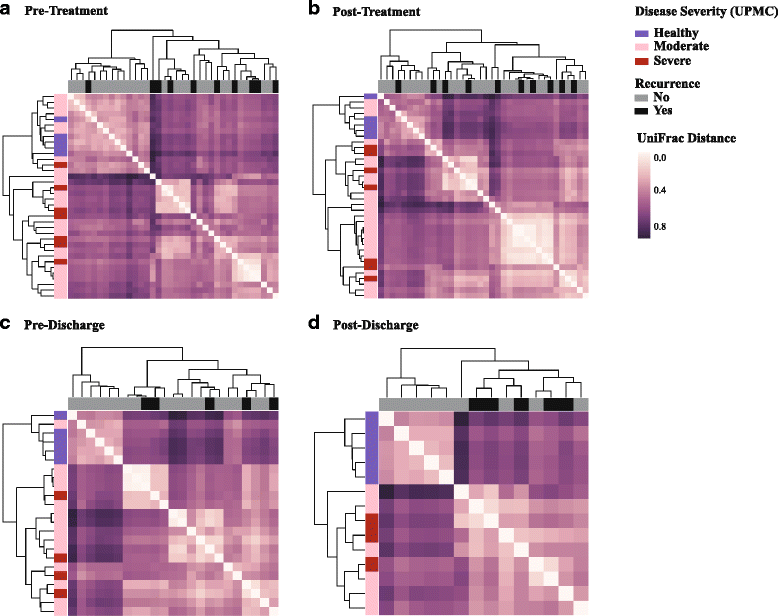Identifying predictive features of Clostridium difficile infection recurrence before, during, and after primary antibiotic treatment
- PMID: 29132405
- PMCID: PMC5684761
- DOI: 10.1186/s40168-017-0368-1
Identifying predictive features of Clostridium difficile infection recurrence before, during, and after primary antibiotic treatment
Abstract
Background: Colonization by the pathogen Clostridium difficile often occurs in the background of a disrupted microbial community. Identifying specific organisms conferring resistance to invasion by C. difficile is desirable because diagnostic and therapeutic strategies based on the human microbiota have the potential to provide more precision to the management and treatment of Clostridium difficile infection (CDI) and its recurrence.
Methods: We conducted a longitudinal study of adult patients diagnosed with their first CDI. We investigated the dynamics of the gut microbiota during antibiotic treatment, and we used microbial or demographic features at the time of diagnosis, or after treatment, to predict CDI recurrence. To check the validity of the predictions, a meta-analysis using a previously published dataset was performed.
Results: We observed that patients' microbiota "before" antibiotic treatment was predictive of disease relapse, but surprisingly, post-antibiotic microbial community is indistinguishable between patients that recur or not. At the individual OTU level, we identified Veillonella dispar as a candidate organism for preventing CDI recurrence; however, we did not detect a corresponding signal in the conducted meta-analysis.
Conclusion: Although in our patient population, a candidate organism was identified for negatively predicting CDI recurrence, results suggest the need for larger cohort studies that include patients with diverse demographic characteristics to generalize species that robustly confer colonization resistance against C. difficile and accurately predict disease relapse.
Conflict of interest statement
Ethics approval and consent to participate
Written informed consent was obtained from participants at enrollment. This study was approved by the Institutional Review Board (IRB) at State University of New York Downstate Medical Center and the Massachusetts Institute of Technology.
Consent for publication
Not applicable.
Competing interests
The authors declare that they have no competing interests.
Publisher’s Note
Springer Nature remains neutral with regard to jurisdictional claims in published maps and institutional affiliations.
Figures





Similar articles
-
Clearance of Clostridioides difficile Colonization Is Associated with Antibiotic-Specific Bacterial Changes.mSphere. 2021 May 5;6(3):e01238-20. doi: 10.1128/mSphere.01238-20. mSphere. 2021. PMID: 33952668 Free PMC article.
-
Diluted Fecal Community Transplant Restores Clostridioides difficile Colonization Resistance to Antibiotic-Perturbed Murine Communities.mBio. 2022 Aug 30;13(4):e0136422. doi: 10.1128/mbio.01364-22. Epub 2022 Aug 1. mBio. 2022. PMID: 35913161 Free PMC article.
-
Randomized Controlled Trial of Oral Vancomycin Treatment in Clostridioides difficile-Colonized Patients.mSphere. 2021 Jan 13;6(1):e00936-20. doi: 10.1128/mSphere.00936-20. mSphere. 2021. PMID: 33441409 Free PMC article. Clinical Trial.
-
Current Approaches to Treat and Prevent Recurrence of Clostridioides difficile.Gastroenterol Clin North Am. 2025 Jun;54(2):259-275. doi: 10.1016/j.gtc.2025.02.005. Epub 2025 Mar 24. Gastroenterol Clin North Am. 2025. PMID: 40348487 Review.
-
Ridinilazole: a novel, narrow-spectrum antimicrobial agent targeting Clostridium (Clostridioides) difficile.Lett Appl Microbiol. 2022 Sep;75(3):526-536. doi: 10.1111/lam.13664. Epub 2022 Feb 11. Lett Appl Microbiol. 2022. PMID: 35119124 Free PMC article. Review.
Cited by
-
Gut metabolites predict Clostridioides difficile recurrence.Microbiome. 2022 Jun 9;10(1):87. doi: 10.1186/s40168-022-01284-1. Microbiome. 2022. PMID: 35681218 Free PMC article.
-
Personalized Clostridioides difficile engraftment risk prediction and probiotic therapy assessment in the human gut.bioRxiv [Preprint]. 2024 Jan 4:2023.04.28.538771. doi: 10.1101/2023.04.28.538771. bioRxiv. 2024. Update in: Cell Syst. 2025 Aug 20;16(8):101367. doi: 10.1016/j.cels.2025.101367. PMID: 37162960 Free PMC article. Updated. Preprint.
-
Microbiome profile and calprotectin levels as markers of risk of recurrent Clostridioides difficile infection.Front Cell Infect Microbiol. 2023 Sep 13;13:1237500. doi: 10.3389/fcimb.2023.1237500. eCollection 2023. Front Cell Infect Microbiol. 2023. PMID: 37780848 Free PMC article.
-
Gut Microbial and Metabolic Features Associated With Clostridioides difficile Infection Recurrence in Children.Open Forum Infect Dis. 2024 Sep 3;11(9):ofae506. doi: 10.1093/ofid/ofae506. eCollection 2024 Sep. Open Forum Infect Dis. 2024. PMID: 39319090 Free PMC article.
-
From taxonomy to metabolic output: what factors define gut microbiome health?Gut Microbes. 2021 Jan-Dec;13(1):1-20. doi: 10.1080/19490976.2021.1907270. Gut Microbes. 2021. PMID: 33890557 Free PMC article. Review.
References
-
- Kuijper EJ, Coignard B, Tull P, ESCMID Study Group for Clostridium difficile. European Centre for Disease Prevention and Control Emergence of Clostridium difficile-associated disease in North America and Europe. Clin Microbiol Infect. 2006;12:2–18. doi: 10.1111/j.1469-0691.2006.01580.x. - DOI - PubMed
-
- Gravel D, Miller M, Simor A, Taylor G, Gardam M, McGeer A, Hutchinson J, Moore D, Kelly S, Boyd D, et al. Health care-associated Clostridium difficile infection in adults admitted to acute care hospitals in Canada: a Canadian nosocomial infection surveillance program study. Clin Infect Dis. 2009;48:568–576. doi: 10.1086/596703. - DOI - PubMed
MeSH terms
Substances
LinkOut - more resources
Full Text Sources
Other Literature Sources
Medical

